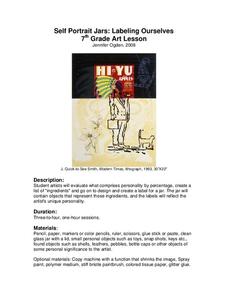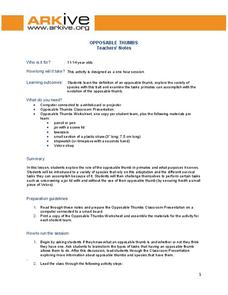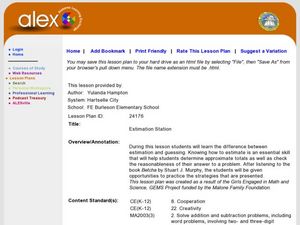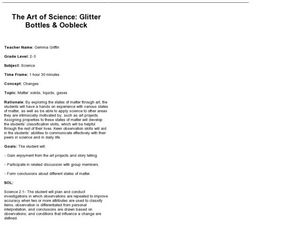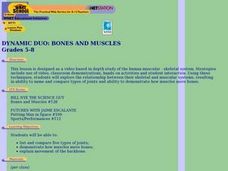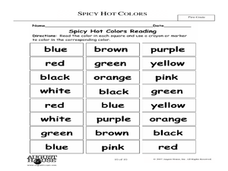Anti-Defamation League
The Name Jar: Discussion Guide for Grades Pre-K–1
A activity spotlights the story, The Name Jar, by Yangsook Choi. After a read-aloud, the class retells the story using puppets or dress-up. They participate in a thoughtful discussion about the story, answer questions relating the book...
Curated OER
What’s your Name?
Youngsters work to build empathy, cultural understanding, and a sense of self as they uncover the story behind their own names. They read the book, The Name Jar, discuss immigration and how it feels to be in a new place. Then, they...
Curated OER
The Name Jar
Students participate in a lesson that focuses on the literature of Korea. "The Name Jar" is read by students to practice some essential reading skills. This would include the recognition of sequence in a story, characterization, and...
Curated OER
How Much is a Name Worth?
Second graders listen to a read aloud of Yangsook Choi's, The Name Jar. First, they estimate how much their name is worth based on the teacher's example. They assign numeric values to the letters of the alphabet in order to compute the...
Curated OER
Germination: Name that Seed
Students investigate seeds, flowers and germinating seeds. In this germination lesson plan, students observe a stalk of corn, a corn seed, Gladiolas and glass jars containing germinating sees and plants. Students answer 8 questions...
Curated OER
Self Portrait Jars: Labeling Ourselves
Seventh graders create an alternative self-portrait. In this art lesson students study the artwork of Jaune Quick-to-See Smith. Students use her work as inspiration for a self-portrait in a jar form.
Curated OER
Leyden Jar: Static Electricity
Students experiment with a Leyden Jar, a device that stores electrical charges. A large voltage can be built up in this jar by adding more and more charge. The modern name for this device is a capacitor.
Curated OER
Mystery Jars: Make Your Own
Students explore the concept of estimation. In this estimation lesson, students create their own estimation jars and fill them with objects of their choice. Students then count the exact number of objects and trade jars to repeat.
Curated OER
Who Took the Cookies
Students find the missing cookies. In this language arts lesson, students solve the mystery of who is taking the cookies from the cookie jar. Students are read several books with the same mystery of cookies being taken from the jar.
ARKive
Opposable Thumbs
How do opposable thumbs help you complete certain tasks? An activity about evolutionary traits prompts learners to try writing their name, twist the lid off of a jar, and use tweezers to pick up a straw, first with their normal grip, and...
Alabama Learning Exchange
The Water Cycle
Learners identify the stages of the water cycle. They listen to the book "Magic School Bus: Wet All Over," examine the Build Your Own Water Cycle website, predict and measure the amount of water in a jar for a week, and read a short play...
Alabama Learning Exchange
Estimation Station: Why Estimating is Better than Guessing
Youngsters discover the difference between estimating and guessing. They estimate how many items are contained in a jar as they read a story. After the story, pupils discover the differences between estimating and guessing and create a...
Curated OER
Solar Sweet Tea
Learners study the sun. In this heat energy instructional activity, students use the sun's warmth to make tea. They place a few jars with tea bags and water in the sun and discuss what the sun is doing to the water while they wait for...
Curated OER
The Art of Science: Glitter Bottles and Oobleck
After having a class discussion on the three states of matter, young scientists utilize the wonderful substance, Oobleck in order to experience something that changes states of matter. They also create "sparkle jars" which...
KOG Ranger Program
How Things Burn
What is the fire triangle? Young ranger learn about the three elements needed to start a fire and keep it going (heat sources, fuel sources, and oxygen) with a class demonstration involving a candle in a jar.
Education Outside
What Are Grains?
This activity is like having a show-and-tell. Bring in lots of items, or packaging, from the grain group. Bread, rice, cracker, cereal, oats, you get the idea. Perhaps first start by checking in and asking what the class knows about...
Curated OER
Outgassing
Learners demonstrate the concept of outgassing and to explain the origins of the earth's atmosphere. They perform a simple experiment using glass jars, two antacid tablets, and some water. This experiment does a good job in demonstrating...
Curated OER
Calculating Your Foodometer
Young scholars explore environmental issues by completing a food production class activity. For this carbon footprint lesson, students discuss the types of foods they eat, where they come from and what types of methods are used to...
Curated OER
Bugs, Bugs, Everywhere!
Students collect and compare bugs using magnifying lenses and graph data based on their comparisons. In this bugs lesson plan, students also make an aspirator by using a jar, tubing, and screen.
Education Outside
Grains and Food
Gather up a variety of foods made from grains. Cereal, oats, pasta, rice, breads, cookies, crackers, to name a few. Put them in plastic containers or plastic bags. Then do a show-and-tell type demonstration and present all the types of...
Curated OER
Dynamic Duo: Bones and Muscles
Students explore the relationship between their skeletal and muscular systems, resulting in ability to name and compare types of joints and ability to demonstrate how muscles move bones.
Curated OER
Who Dirtied The Water/Clean Water: Is It Drinkable?
Students enter the room, receive a film canister that contains materials that be added to the dirty water bell jar. They record on their data table who or what is doing the adding and the actual substance that has been added to the bell...
Curated OER
Signs of the Wind
Students discover the properties of wind. They name as many wind words as they can. (breezy, windy, blustery, gust, tornado, hurricane, stormy, etc.) and use vocabulary, movement, and props to illustrate winter weather concepts such as...
Curated OER
Spicy, Hot Colors
Students demonstrate an understanding of colors. In this visual arts activity, students read the text Hot, Spicy Colors and name their favorite colors. Students complete a bar graph to show the data. Students discuss how each color can...
Other popular searches
- The Name Jar
- The Name Jar Young's
- Name Jar Story
- The Name Jar Story
- Name Jar Choi
- Name Jar Youngsook
- Name Jar Chou
- Name Jar Young's







